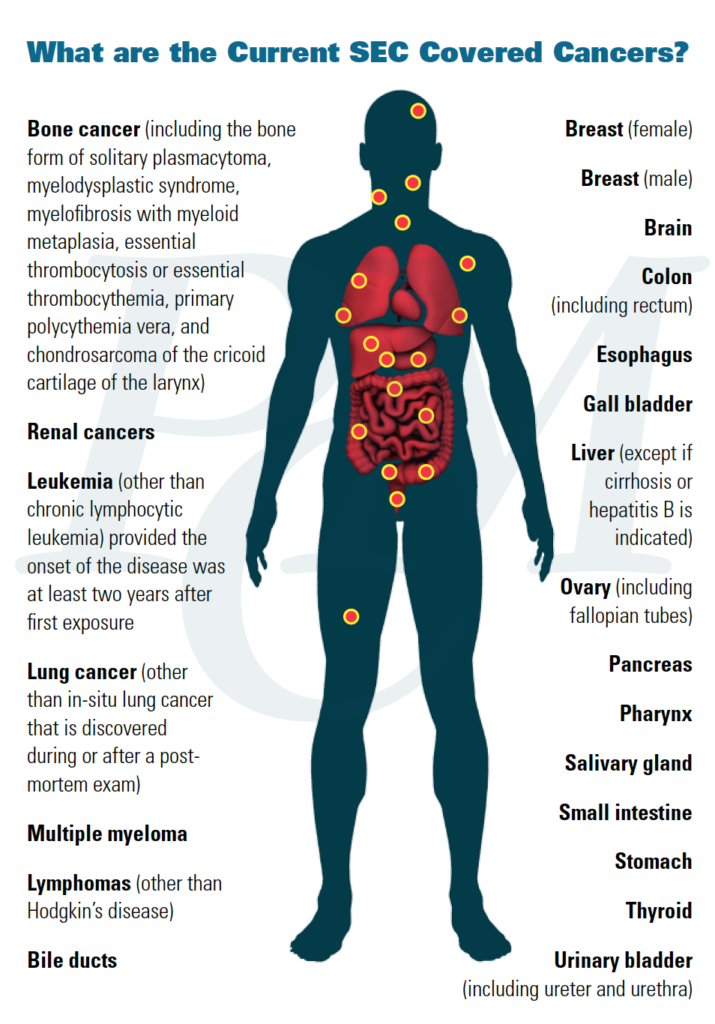Nuclear Weapons Worker Program

You Could be Eligible for Monetary
and Health Care Benefits
From the inception of the Manhattan Project up to the present day, more than 1,000,000 workers have served the United States by building America’s nuclear weapons. Over the years, many of these workers have become ill due to their exposure to radioactive and toxic substances. The Energy Employees Occupational Illness Compensation Program Act (EEOICPA), effective in July 2001, was created to provide monetary compensation and free health care benefits to nuclear weapons workers who got sick as a result of their workplace exposure. EEOICPA benefits are administered by the U.S. Department of Labor. Qualifying beneficiaries include employees, contractors, and subcontractors who worked at any of the U.S. Department of Energy or Atomic Weapons Employer facilities covered under this program.
EEOICPA provides qualified sick workers with both free health care and monetary compensation.
Health Care Compensation:
Workers qualifying for EEOICPA receive free lifetime health care related to their covered medical conditions. This free health care is not subject to any co-pays or deductibles and includes coverage of all doctor visits, hospitalization costs, medical treatments, prescriptions, medical equipment and in-home health care.
Monetary Compensation:
Monetary benefits differ depending on the worker’s specific claim and eligibility criteria. Benefits are divided into two parts: Part B and Part E.
Part B compensation includes:
- One lump-sum, tax-free cash compensation of $150,000.
Part E compensation includes:
- Incremental tax-free cash compensation totaling up to $250,000, depending on the worker’s level of impairment ($2,500 for each 1% of impairment). Impairment is determined through an impairment evaluation by a certified, EEOICPA-enrolled physician . Workers may locate qualified doctors by contacting PCM Impairments at 866-548-4079 or their local U.S. Department of Labor Resource Center.
- Individuals who initially receive less than the maximum compensation of $250,000 may be eligible for additional financial compensation over time if their health condition deteriorates. Anyone holding a U.S. DOL white medical benefits card qualifies for a new impairment evaluation every two years.
- Additional compensation may be available to workers who experienced wage losses as a result of their covered conditions. Total monetary compensation under both parts of the program max out at $400,000. Eligibility for Part B or Part E compensation depends upon the individual’s diagnosis and workplace exposure. More information is provided below.
Survivor benefits may also be available for family members of deceased workers. More information on the benefits and how to file claims are available at the U.S. Department of Labor Resource Centers.
To determine whether an individual qualifies for EEOICPA benefits, he or she must have a diagnosed illness that resulted from workplace exposure to radiation or toxic substances from a qualifying U.S. Department of Energy facility. Employees, contractors, and subcontractors are all eligible for benefits. The diagnosis will determine whether an individual files a Part B or Part E claim.
Diagnoses eligible for Part B or Part E benefits
Workers’ eligibility for Part B vs. Part E benefits depends on their medical diagnosis and the location at which they worked.
Part B Diagnoses
Workers diagnosed with chronic beryllium disease, beryllium sensitivity, silicosis or any type of cancer should file a claim for Part B benefits. Certain cancers designated as “special exposure cohort” (SEC) cancers receive automatic eligibility consideration under Part B (see below).
Part E Diagnoses
Workers diagnosed with any other work-related illness not covered under Part B above should file a claim for Part E benefits.
Determining Workplace Exposure
To determine whether an illness resulted from workplace exposure, the U.S. Department of Labor uses one of two methods: dose reconstruction or special exposure cohort (SEC) status.
Dose Reconstruction
Dose reconstruction is an analysis of the amount of radiation or toxic material a worker was exposed to during his or her employment. This is conducted by the National Institute for Occupational Safety and Health (NIOSH). NIOSH looks at the dates and location of employment to determine the likelihood the worker contracted the illness as a result of his or her work.
Special Exposure Cohort (SEC)
A special exposure cohort (SEC) is an automatic eligibility designation for certain classes of employees. There are over 116 SECs covering employees, contractors, and subcontractors who worked at specified facilities, during specific time periods, for at least 250 days.
There are 22 types of cancer covered under the SECs. The SEC cancers covered are:

For more information about qualifying illnesses and the documentation required, PCM encourages workers to contact their local U.S. Department of Labor resource center or the PCM Help Center or 866-387-2123. PCM’s Help Center can help workers navigate the claim filing process.
A worker must have a diagnosed eligible illness before filing a claim for EEOICPA benefits. Claims are filed through the worker’s local U.S. Department of Labor (DOL) Resource Center. Some workers may be required to provide additional medical records and proof of employment at a covered facility. The resource center then sends the claim to a district office. A District Office will usually respond within 30 days to confirm that the claim has been received. A claims examiner will be assigned to the case, and will let the worker know if other information is required to determine his or her eligibility for benefits.
PCM also operates a Help Center to help workers navigate the process. Anyone interested in more information about the program or the claims process may contact the PCM Help Center at 866-387-2123.
